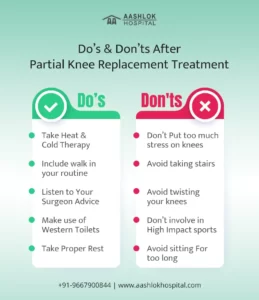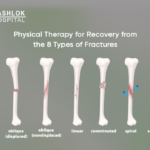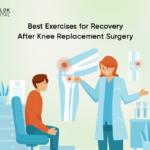
A partial knee replacement surgery is a surgical procedure in which the damaged portion of the knee joint (usually the inner side) is replaced with an artificial prosthesis. The particular part of the knee that needs replacement is restored using metal and plastic units.
Table of contents
Feel free to skip ahead if one topic catches your eye:
- What is Partial Knee Replacement?
- Latest Advancement in Knee Replacement Surgery
- Types of Partial Knee Replacement approaches
- What to expect From Partial Knee Replacement Surgery?
- Precautions After Knee Replacement surgery
What is partial knee replacement?
Partial knee replacement surgery is a good alternative to a full knee replacement procedure where the specific components of the damaged knee joint are replaced with prosthetics.
Read More : All you need to know about – knee surgery
Who needs it?
- People with osteoarthritis of the knee
- The knee damage is limited to only one compartment of the knee
- If the pain in your knee has not responded to medicines
- Knee pain persists in spite of a healthy lifestyle and an optimum weight
- The anterior cruciate ligament of the knee is unscathed.
- The radiology findings correspond with the symptoms

Latest Advancement in Knee Replacement Surgery
Today, advancements in knee arthroplasty or knee surgery have progressed to develop the technique of the surgery as well as offer the best possible experience to the patient. Also known as uni Compartmental knee replacement, the factors that affect the outcome are important.
Some of them include:
- Enhancing patient selection
- Optimizing preoperative care
- Enhancing efficiency with AI and robotics
- Taking implant design to the next level with 3D printing
Enhancing patient selection
- The presence of an established knee impairment affecting knee function
- Presence of an abnormal knee pathology that can be ascribed to the symptoms such as pain, impaired mobility, etc
- Both the above factors justify the reasons for surgery and its risks as compared to the benefits
- The failure of non-surgical measures to treat the symptoms such as drugs, moderate exercise, weight loss
After confirming the above guidelines, there are factors pertaining to the patient and influencing the selection of the patient for partial knee surgery :
- Age – Patients between 30 till any age are at the right age for the procedure
- The mental health status of the patient includes anxiety, depression, pain behavior, etc.
- The severity of the disease- Those with damage confined to a particular component of the knee
- A joint condition affecting the quality of life including daily activities such as mobility, walking, etc
The knee operation cost will depend on the type of replacement.
Read More : 5 Ways To Manage Pain After Knee Replacement
Optimize preoperative care:
Optimizing pre-operative care is an integral part of improving and maintaining and maximizing post-operative recovery. Preoperative approaches that positively influence the outcomes include:
- Exercise and fitness
- Physiotherapist supervised exercise intervention
- Acupuncture
- Medical optimization that includes:
- Diabetes management- Monitoring HbA1C and keeping it lower than 6
- BMI less than 45 to prevent wound healing complications, cardiovascular complications, renal failure, and infection
- Cardiovascular management- Stopping anticoagulant drugs after consultation with a cardiologist
- Blood transfusion timing
- A history of renal disease and drug intake for the same
- Preventing infection with methicillin-resistant Staphylococcus aureus (MRSA)
- Avoid drug, alcohol, and tobacco abuse
- Prevention of thromboembolism- By using compression device as well as agents such as warfarin, enoxaparin, aspirin, dabigatran etc
- Pain management using NSAIDs and oral opiate agents
- Counseling- To encourage realistic expectations from the patient
- Social support- Building a social support system that will reduce anxiety, panic, depression, and fear thereby improving postoperative results.
Enhancing efficiency with AI and robotics:
The use of artificial intelligence and robotics in knee arthroplasty has the following benefits:
- Has smaller incisions
- The surrounding tissues of the joint are left undisturbed
- Helps the surgeon to plan for 3D bone reconstruction
- Enable ligament evaluation during surgery
- Improve the alignment and positioning of the prosthesis
Taking Implant Design to the Next Level with 3D Printing.
Knee arthroplasty has been taken to a whole another level with 3D printing. The incorporation of 3D printing enables:
- The best quality high-resolution imaging of the knee
- Generating a computer model of the patient’s existing joint
- Creating a 3D image of the prospective joint
- Joint placement using a surgical approach wherein the positioning, tilting, and fixing of the prosthesis is greatly enhanced in quality with 3D guided technology
Also Read : Best Exercises for Recovery After Knee Replacement Surgery
Types of Partial Knee Replacement Approaches
Depending upon the compartment of the knee involved, different types of partial knee replacement surgery may be necessary.
Unicondylar knee replacement
When only one compartment of the knee needs replacement, a unicondylar knee replacement is the procedure of choice.
- It is a less invasive procedure and a great alternative to total knee arthroplasty
- The procedure is mostly performed in older patients with a low BMI (less than 60 years)
- The implant is kept in place after preparing and shaping the knee bone and the tibia
- If you do not have rheumatoid arthritis, have intact ligaments, then the procedure is right for you.
- Right total knee arthroplasty or a one on the left side may be performed
Patellofemoral knee replacement
For people with knee damage that is localized to the anterior aspect of the knee, patellofemoral knee replacement is the right procedure.
- This procedure replaces the kneecap on the anterior part of the knee
- A prosthetic knee cap is fixed along with the corresponding joint surface to ensure smooth movement
- If you have problems with climbing stairs, walking on raised surfaces, bending the knee, etc, then this is the right type for you.
- The duration of hospital stay is lesser than that of a total knee replacement
Bicompartmental knee replacement
- Also known as bicompartmental knee surfacing, this procedure offers a better range of motion and is less invasive than a total knee replacement
- This procedure is suited for people where 2 of the 3 compartments of the knee need replacement
- When the arthritis of the knee is in one or two of the compartments is moderate
What to expect from a partial knee replacement surgery?
- After an assessment, the procedure is performed
- Expect to feel minimal or tolerable pain for a few days following the surgery
- The procedure is less invasive than a complete knee replacement
- You may need to stay in the hospital for about two to four days
- The recovery period for the procedure is about six to eight weeks
- Medial knee pain exercises and other activities to improve joint mobility
- Swelling will subside after a few weeks
- Physiotherapy and motion exercises will be a part of your rehabilitation to strengthen knee muscles
- Continue pain medications and other prescriptions as instructed by the doctor
- The knee operation cost will depend on your joint condition and the type of surgery required
Read More : Knee Replacement Cost in India: How to Choose the Right Surgeon and Hospital
Precautions to take after partial knee replacement surgery
- Avoid activities such as running and jumping
- Stay away from high impact activities and aerobics
Takeaway
Aashlok hospital has been synonymous with the best patient care for quite some time now. Our specialists value patient health and the standard of care as their priority. Our support staff is also fully equipped to help you throughout the time you consult with us. Your health and safety are our priority and we strive to always provide the most advanced and safe treatments possible to improve your quality of life.












